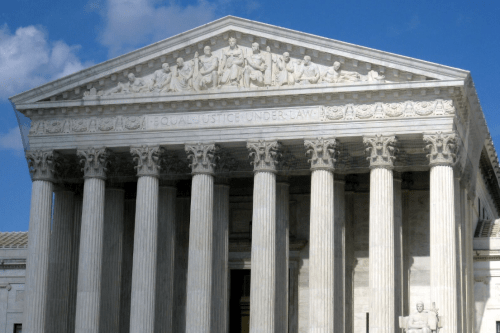Introduction
A consensus is beginning to emerge in the public and political spheres concerning the non-criminal detention of terrorist suspects. Over the past several years, non-criminal detention of Al Qaeda and Taliban captives at Guantánamo Bay, Cuba has sharply divided the American polity. Since the change in administration, however, it has become increasingly clear that the United States—even under a Democratic administration and with substantial Democratic majorities in both houses of Congress—is not going to abandon long-term detention of terror suspects and revert to a pure law enforcement model for incapacitating them, and it is not going to deal with the population of Guantánamo on the basis of freeing everyone whom it cannot prosecute. While the developing consensus still has many dissenters, the real question now is not whether America will have some detention system, but what sort of detention system, designed by whom, and using what rules.
In his recent speech at the National Archives on national security strategy and law, President Obama placed himself solidly within this emerging body of thought. He recognized that protecting our national security may require a non-criminal detention system for terrorists who cannot be tried but are too dangerous to release. And he made clear that this system needs to be fair and rigorous, supervised by the federal courts and created by an act of Congress. The president called for a system that has “clear, defensible, and lawful standards,” “fair procedures so that we don’t make mistakes,” and “a thorough process of periodic review, so that any prolonged detention is carefully evaluated and justified.”[i]
This paper, and the model legislative text we have attached as an appendix, is an effort to imagine such a regime at the granular level of actual legislative language. Much commentary and speculation has focused on the form that this new regime should take, rather than on the details of the many questions a detention regime will need to address. In the wake of the Supreme Court’s decision in Boumediene v. Bush,[ii] it is inevitable that federal judges will ultimately oversee any such detention system. Aside from this one general feature, however, the framework for the new system remains wide open in any number of respects.
The necessity of a preventative detention apparatus is the result of the unique nature of America’s conflict with transnational terrorist organizations and the limits of existing laws, both international and domestic, in responding to current threats. Defense Secretary Robert Gates recently testified that, after Guantánamo closes, there will remain a residual group of 50 to 100 Guantánamo detainees who cannot be tried yet are too dangerous to release.[iii] Yet the structural issues that generate this group actually implicate a larger population than those currently held at Guantánamo. Any new detention regime will need to address not only Guantánamo detainees but also similar detainees held elsewhere and other terrorists captured in the future outside of zones of active military operations.
The debate over what to do both with these residual Guantánamo detainees and with future captives in global counterterrorism operations has largely focused on which legal regime should serve as the reference guide. Commentators from across the spectrum have debated the merits of the law-of-war versus the criminal-law paradigms. But except in the broadest terms, this debate does little to advance the discussion on how exactly we should detain suspected terrorists—or, indeed, how we should define the category of suspected terrorists we mean to detain.
Meanwhile, advocates of a non-criminal detention scheme have tended to focus on the possibility of creating a national security court. Proponents argue that a national security court could bridge the divide between the law-of-war and criminal-justice paradigms, using elements of both to create a new system responsive to modern security threats. A national security court would be staffed by federal judges, buttressing the legitimacy of any detention regime. It could address issues such as the protection of classified information and the consideration of evidence which federal courts would normally exclude from criminal proceedings. Suggested national security court models have ranged from a stand-alone institution comparable to the Foreign Intelligence Surveillance Court to simply giving exclusive jurisdiction over detention cases to the federal district court in the District of Columbia. National security court advocates have suggested their use to oversee wartime detentions, to conduct trials for suspected terrorists, or both.
Yet national security court critics have argued that such proposals are significantly underdeveloped in both form and function. As one opponent writes, these proposals are “dangerously myopic proxies for larger debates that must be resolved first.”[iv] And the critics have a point. Many proposals for national security courts offer an institutional solution (creating a new court) for what is really a substantive set of problems: We, as a society, have not yet decided on the rules that will govern terrorist detentions. We have not yet decided the substantive standards, procedural elements, or rights of the accused within the processes in question. These issues are far more important than what building the adjudication will take place in or what to call the institution that will do the adjudication.
Given that there will be a residual group of Guantánamo detainees and that the president intends, as he put it, to “work with Congress to develop an appropriate legal regime” to govern their detentions, now is the time to answer these important questions. Jack Goldsmith, in a paper earlier this year, identified several key questions any detention legislation will have to address:[v]
- Who falls within the definition of the detainable class?
- What are the evidentiary and procedural rules?
- How much of the proceedings should take place in public?
- How often should detention decisions be reviewed?
- What rules should govern access to classified information?
- Should the court be a stand-alone institution?
- Should the court make first-order detention decisions or review detention decisions made by the military?
In this paper, we do not intend to argue for a preventative detention regime but, rather, to design one—to pose one set of answers to these questions with sufficient precision to produce actual legislative language. For those unconvinced of the necessity of such a law, there is a voluminous literature—including several works by one of the present authors.[vi] Our aim here is to elaborate on this previous work, on the work of other writers and scholars, and on subsequent legal developments in both U.S. courts and international jurisprudence in an effort to address Goldsmith’s questions head on. That is, we aim to begin the process of translating the emerging consensus that some detention apparatus is necessary into actionable legislation, to bring the debate down from a high-altitude argument over first principles to a more practically useful discussion of what a coherent approach to non-criminal terrorism detentions ought to look like. The attached model detention law is a further effort to translate the choices we put forward into actual legislative language, which we offer as a kind of discussion draft as Congress begins to contemplate President Obama’s request.
In addressing the design elements of a detention law, rather than arguing for one, we necessarily take as given several assumptions that many readers may still regard as premature. First, we assume that the laws of war do not offer an adequate legal framework for the detention of terrorist suspects. The detention system they envision relies on numerous premises which do not hold true for conflicts with global terrorist organizations—for example, that it is fairly simple to distinguish those who are participating in hostilities from those who are not, that the nationality of the participants should determine their rights, and that conflicts will end in an identifiable manner. Conflicts with terrorist organizations buck these premises, and therefore render the framework provided by the Geneva Conventions incomplete, and arguably ill-suited, for a long-term conflict with Al Qaeda.
Second, we assume that reliance solely on domestic criminal law to incapacitate transnational terrorists is untenable. The rules of procedure and evidence for criminal trials create too high a bar to detain terrorists arrested in the far corners of the earth under circumstances less than favorable for the collection of evidence. People against whom evidence may not come close to proving criminal culpability may still pose an unacceptable danger as a result of frankly-acknowledged allegiance to enemy organizations, evidence that would be inadmissible in criminal proceedings, or evidence that cumulatively falls short of proof beyond a reasonable doubt of criminal conduct. Efforts to shoehorn terrorism cases into the criminal justice system may also have serious negative repercussions for the conduct of domestic criminal trials more generally.[vii] We assume, in short, that the appropriate detention regime for counterterrorism purposes will draw on both the criminal-law and law-of-war traditions but is ultimately very much its own animal.
We proceed in five parts. In the first section, we lay out a general overview of the model detention statute we envision, how it would work mechanically and what the legal process under its terms would look like. In the second section, we discuss the model law’s definition of the class of people subject to detention. We next turn to the details of the procedures the model law would employ to adjudicate terrorist detentions. In the penultimate section, we discuss briefly the various accountability mechanisms we have sought to build into the model law. Finally, we conclude with a set of observations concerning how the model law would help insulate traditional wartime detentions from probing post-Boumediene judicial review and preserve a zone of executive discretion for such detentions.
[i] Remarks by the President on National Security, National Archives, Washington, D.C. May 21, 2009. Available at http://www.whitehouse.gov/the_press_office/Remarks-by-the-President-On-National-Security-5-21-09/.
[ii]Boumediene v. Bush, 128 S. Ct. 2229 (2008). Available at http://www.supremecourtus.gov/opinions/07pdf/06-1195.pdf.
[iii] Testimony of Secretary of Defense Robert M. Gates before the Senate Committee on Appropriations, April 30, 2009. See, Sue Pleming, “Gates Grilled Over Fate of Guantanamo Inmates,” Reuters, April 30, 2009.
[iv] Stephen I. Vladeck, “The Case Against National Security Courts” (December 12, 2008). Willamette Law Review, Vol. 45, 2009; American University, WCL Research Paper No. 2008-82. Available at SSRN: http://ssrn.com/abstract=1315337; See also, The Constitution Project, “A Critique of ‘National Security Courts’,” (June 23, 2008). Available at http://www.constitutionproject.org/pdf/Critique_of_the_National_Security_Courts.pdf.
[v] Jack L. Goldsmith, “Long-Term Terrorist Detention and Our National Security Court,” (February 4, 2009). Available at https://www.brookings.edu/~/media/Files/rc/papers/2009/0209_detention_goldsmith/0209_detention_goldsmith.pdf.
[vi] See Benjamin Wittes, Law and the Long War: The Future of Justice in the Age of Terror (New York: Penguin, 2008). See also “Improving Detainee Policy: Handling Terrorism Detainees within the American Justice System,” Testimony before the Senate Committee on the Judiciary, June 4, 2008, available at http://frwebgate.access.gpo.gov/cgi-bin/getdoc.cgi?dbname=110_senate_hearings&docid=f:43658.wais; “A Legal Framework for Detaining Terrorists: Enact a Law to End the Clash over Rights,” with Mark Gitenstein, Brookings Institution Opportunity ’08 Paper, November 15, 2007, available at https://www.brookings.edu/papers/2007/1115_terrorism_wittes_opp08.aspx#; “Terrorism, The Military, and the Courts,” Policy Review, June & July 2007, available at http://www.hoover.org/publications/policyreview/7831532.html; and “Judicial Baby-Splitting and the Failure of the Political Branches,” Terrorism, the Laws of War, and the Constitution, ed. Peter Berkowitz (Hoover Institution Press, 2005).
[vii]See, e.g., Charles D.Weisselberg, “Terror in the Courts: Beginning to Assess the Impact of Terrorism-Related Prosecutions on Domestic Criminal Law and Procedure in the USA.” Crime, Law and Social Change, Vol. 50, Nos. 1-2, pp. 25-46, 2008; UC Berkeley Public Law Research Paper No. 1167482. Available at SSRN: http://ssrn.com/abstract=1167482.


